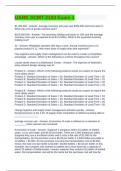UARK SCMT 2103 Exam 1
$1,200,000 - Answer- Average inventory last year was $200,000 and turns were 6.
What was cost of goods sold last year?
$150,000,000 - Answer- The inventory holding cost factor is 10% and the average
inventory next year is expected to be $1.5 billion. What is the expected inventory
holding cost?
33 - Answer- MegaMart operates 365 days a year. Annual inventory turns of a
popular product is 11. How many days of supply does that represent?
How logistics and supply chain management can be used to create a competitive
advantage - Answer- Which of the following is a theme throughout the course?
Locate stores close to a Distribution Center - Answer- The objective of Walmart's
early network design strategy was to:
Product A - Answer- Which of the following products would you expect to require the
most safety stock?
Product A: Standard Deviation of Sales = 30, Standard Deviation of Lead Time = 30
Product B: Standard Deviation of Sales = 25, Standard Deviation of Lead Time = 15
Product C: Standard Deviation of Sales = 20, Standard Deviation of Lead Time = 20
Product D: Standard Deviation of Sales = 20, Standard Deviation of Lead Time = 25
Product B - Answer- Which of the following products would you expect to require the
most safety stock?
Product A: Standard Deviation of Sales = 25, Standard Deviation of Lead Time = 19
Product B: Standard Deviation of Sales = 29, Standard Deviation of Lead Time = 25
Product C: Standard Deviation of Sales = 15, Standard Deviation of Lead Time = 20
Product D: Standard Deviation of Sales = 25, Standard Deviation of Lead Time = 20
change logistics and supply chain management activities quickly - Answer-
Responsiveness in the 4 R's of supply chain competition is defined as being able to
_________________.
average cost per unit - Answer- Economies of scale is defined as a reduction in
________ when volumes are increased.
Economies of scale - Answer- Suppose a company orders 10 pallets of bottled
water, 14 oz. per bottle, and $0.05 per bottle. There are 2,000 bottles per pallet.
Suppose they use a truckload carrier and it costs a flat rate of $1,000 for the
transportation. So the purchase cost is $0.05 per bottle X 2,000 bottles per pallet X
10 pallets = $1,000. So the purchase cost plus the transportation cost is $2,000,
hence, the total cost per bottle is $2,,000 bottles = $0.10 per bottle. In this
example, the company only ordered 10 pallets but a truck load has a capacity of
about 20 pallets of bottled water. Instead, suppose they ordered 20 pallets of bottled
water, the transportation cost will be the same but the purchase cost will now be
, $0.05 per bottle X 2,000 bottles per pallet X 20 pallets = $2,000. Hence the purchase
cost plus the transportation cost is $3,000, so the total cost per bottle is $3,000 /
40,000 bottles ˜ $0.08 per bottle (rounded up from $0.075 per bottle). This
demonstrates which of the following concepts?
integration - Answer- Supply chain management is the management of the _______
of business processes between functions in a firm and with suppliers and customers.
the order of activities - Answer- Process improvement is concerned with increasing
the speed of the process, reducing the cost of the process, or increasing the
reliability of the process, without changing ____________.
150 - Answer- A distribution center has 180,000 pounds of sugar and the forecast is
1,200 pounds of sugar per day. What is the estimate of the days of supply?
Total cost of ownership - Answer- _____________ is the idea that there are many
other costs than just the acquisition cost that should be accounted for in a purchase.
post-transaction - Answer- The ___________ component of customer service
includes such factors as availability of spare parts, technical support, feedback and
complaint processes, et cetera.
0.50 - Answer- Imagine you are a small format grocer and that on average you sell
30 squash per day. Some days you sell more and some days you sell less, but on
average you sell 30. In fact, you have been doing this for a while and have
calculated the probability of selling different quantities of squash, reproduced in the
table of discrete probabilities below.
Quantity Sold Probability
20 0.10
25 0.20
30 0.40
35 0.20
40 0.10
You have decided to stock fewer squash and instead stock more tomatoes. You
decided to stock 35 squash each day. About how many sales of squash do you
expect to lose each day as a result of this decision to stock more tomatoes?
percentage of items in stock - Answer- Perpetual inventory is one of the major ways
that percentage of time in stock and ________________are measured.
75 units - Answer- The amount received by a firm is 100 units and it sold 25 units.
Assuming initial inventory is zero, what is the perpetual inventory?
The percentage item fill rate (IFR) - Answer- _____________________tells you how
much demand you are losing using the percentage of demand fulfilled from on hand
inventory.




